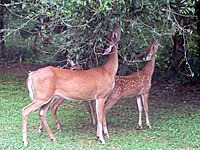
Photo from wikipedia
Accumulating evidence suggests that herbivorous insects influence local composition and richness of Neotropical plant species, particularly in species-rich genera. Species richness, phylogenetic diversity, and chemical diversity all influence the ability… Click to show full abstract
Accumulating evidence suggests that herbivorous insects influence local composition and richness of Neotropical plant species, particularly in species-rich genera. Species richness, phylogenetic diversity, and chemical diversity all influence the ability of insect herbivores to find and utilize their hosts. The relative impact of these components of diversity on species coexistence and plant-herbivore interactions is not well understood. We constructed 60 local communities of up to 13 species of Piper (Piperaceae) in native, mature forest at a lowland wet forest location in Costa Rica. Species composition of each community was chosen such that species richness, phylogenetic diversity, and GCMS-based chemical diversity were varied independently among communities. We predicted that chemical diversity would most strongly affect the communities across time, with smaller effects of taxonomic and phylogenetic diversity. Thirteen months after the experimental planting, we assessed survivorship of each cutting, measured total leaf area loss of the survivors, leaf area loss to generalist and specialist herbivorous insect species, and local extinction of species. Generalist and specialist herbivory decreased with increasing levels of species richness and phylogenetic diversity, respectively. Surprisingly, there was no independent effect of chemical diversity on any of the three measures of herbivore damage. Nevertheless, plots with a higher chemical and phylogenetic diversity showed decreased plant mortality and local species extinction. Overall, our results suggest that both chemical and phylogenetic similarity are important factors in the assembly and maintenance of tropical plant communities. The fact that chemical diversity influences plant mortality suggests that leaf herbivores, and possibly other plant natural enemies, could increase plant diversity via selective mortality of similar chemotypes.
Journal Title: Ecology
Year Published: 2022
Link to full text (if available)
Share on Social Media: Sign Up to like & get
recommendations!